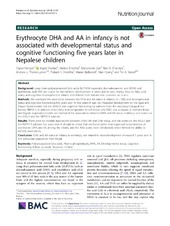| dc.contributor.author | Henjum, Sigrun | en_US |
| dc.contributor.author | Kvestad, Ingrid | en_US |
| dc.contributor.author | Shrestha, Merina | en_US |
| dc.contributor.author | Ulak, Manjeswori | en_US |
| dc.contributor.author | Chandyo, Ram K. | en_US |
| dc.contributor.author | Thorne-Lyman, Andrew L. | en_US |
| dc.contributor.author | Shrestha, Prakash S. | en_US |
| dc.contributor.author | Kjellevold, Marian | en_US |
| dc.contributor.author | Hysing, Mari | en_US |
| dc.contributor.author | Strand, Tor A. | en_US |
| dc.date.accessioned | 2019-01-25T15:20:31Z | |
| dc.date.available | 2019-01-25T15:20:31Z | |
| dc.date.issued | 2018-07-19 | |
| dc.Published | Henjum S, Kvestad I, Shrestha M, Ulak M, Chandyo RK, Thorne-Lyman AL, Shrestha PS, Kjellevold MK, Hysing M, Strand TA. Erythrocyte DHA and AA in infancy is not associated with general development five years later in Nepalese children. Nutrition Journal. (2018) 17:70 | eng |
| dc.identifier.issn | 1475-2891 | |
| dc.identifier.uri | https://hdl.handle.net/1956/19001 | |
| dc.description.abstract | Background Long chain polyunsaturated fatty acids (LCPUFA) especially docosahexaenoic acid (DHA) and arachidonic acid (AA) are crucial for normal brain development in utero and in early infancy. Data on fatty acid status and cognitive development in infants and children from low-income countries are scarce. Methods We examined the association between the DHA and AA status in infancy (n = 320) and developmental status and cognitive functioning five years later. At five years of age, we measured development by the Ages and Stages Questionnaire 3rd. ed. (ASQ-3) and cognitive functioning by subtests from the neuropsychological test battery NEPSY II. In addition, infant fatty acid composition in red blood cells (RBC) was analyzed. In multiple linear and logistic regression models, we estimated the associations between DHA and AA status in infancy and scores on the ASQ-3 and the NEPSY II subtests. Results There were no notable associations between infant AA and DHA status, and the scores on the ASQ-3 and the NEPSY II subtests five years later. It should be noted that we found better than expected concentrations of erythrocyte DHA and AA among the infants, and the ASQ scores were left-skewed, which limited the ability to identify associations. Conclusion DHA and AA status in infancy is seemingly not related to neurodevelopment measured 5 years later in this peri-urban population from Nepal. | en_US |
| dc.language.iso | eng | eng |
| dc.publisher | BMC | eng |
| dc.rights | Attribution CC BY | eng |
| dc.rights.uri | http://creativecommons.org/licenses/by/4.0/ | eng |
| dc.subject | Polyunsaturated fatty acids | eng |
| dc.subject | Plasma phospholipids | eng |
| dc.subject | DHA | eng |
| dc.subject | AA | eng |
| dc.subject | Developmental status | eng |
| dc.subject | Cognitive functioning | eng |
| dc.subject | Follow up study | eng |
| dc.subject | Nepalese children | eng |
| dc.title | Erythrocyte DHA and AA in infancy is not associated with general development five years later in Nepalese children | en_US |
| dc.type | Peer reviewed | |
| dc.type | Journal article | |
| dc.date.updated | 2018-08-26T06:44:01Z | |
| dc.description.version | publishedVersion | en_US |
| dc.rights.holder | Copyright The Author(s). 2018 | |
| dc.identifier.doi | https://doi.org/10.1186/s12937-018-0375-5 | |
| dc.identifier.cristin | 1604521 | |
| dc.source.journal | Nutrition Journal | |
| dc.subject.nsi | DHA | en_US |

